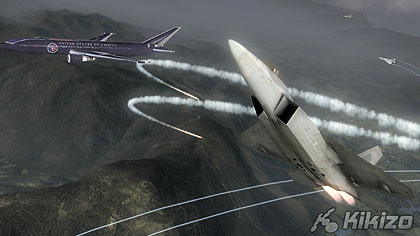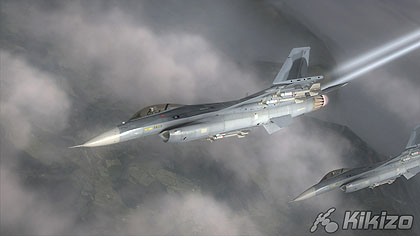Lord of the Rings: Conquest Hands-On
Brand new impressions of Clancy's airborne epic.
Page: 1 2
Page 2
A window pops open in the bottom-right corner. Suddenly we're being lectured by a buzzcut in fatigues, hollering and bitching, fly-boys this and covering-fire that and where-am-I-supposed-to-send-my-wounded-goddamnit. But we turn a deaf ear to his complaints, because this is actually our third play-through of the Rio de Janeiro mission, and we're back this time for the sheer aerodynamic hell of it. We wheel around primly, hit the afterburners and take aim at the hundred-foot concrete Christ the Redeemer looming atop Corcovado mountain. He's a wily one, is Jesus, and it takes us a good four or five tries before we successfully clip one of his outstretched arms, instantly destroying our aircraft and scorching the Messiah a sacrilegious shade of brown.
It's a good sign when you find yourself replaying missions in a preview event, irreligious conduct notwithstanding. There were four of them in the build Ubisoft Romania cooked up for our multiplayer hands-on in December, each playable solo or, as was our lot, with three allied players (the eight-player deathmatch mode remained unseen and unheard, sadly). The entire campaign can be enjoyed in online co-op, and you can drop in and out of another player's game without having to reboot the mission: HAWX will quietly ramp up the number of objectives and opponents to suit. Any upgrades, new load-outs or new planes you've unlocked in single player go into a co-op mission with you, and any you experience points you accumulate while you're there accompany you back out.
Two missions - "Glass Hammer", the Rio de Janeiro outing, and "Adder", which takes place above a non-descript desert - offer relatively clear-cut area defence against progressively tougher waves of ground, air and sea-based enemies. It's harder to nail ground troops over Rio de Janeiro, as tanks squirrel themselves away in the urban thicket, but both missions are rather gentle, and there wasn't much incentive to fight as a team. Other players were generally forgotten a minute or two long of the loading screens, as the above self-indulgent anecdote will suggest (speaking of which, those loading screens definitely outstay their welcome - we hope they won't survive the leap from pre-beta to final code).
The remaining missions pile on the odds the first two lack, thankfully. "Torchlight" tasked us with safeguarding Air Force One against a mysterious terrorist threat, a challenge to which our team rose courageously but with about as much military intelligence as a box of fireworks. After the US Armed Forces had lost their commander-in-chief twice over we learned (or rather, were impatiently instructed) to make use of the expandable mini-map in bottom left, which showed the sensor range of the enemy fighters. Entering a fighter's sensor field forced it to engage us in combat, and the group was accordingly split between nippier planes like the Eurofighter Typhoon, who would venture out to pin down approaching squadrons, and aerial fortresses like the A-10 Terminator, who would hang back alongside the President's vehicle and spit cluster missiles at those who made it through.
"Stiletto" is the most complicated of the four, but despite this and the scaling challenge factor it didn't quite have our cooperative juices flowing like "Torchlight". The idea is to sniff out and disable radar beacons (whilst avoiding radar detection in the process) to give allied bombers a clear run at a facility. In theory this should have prompted real teamwork, but our attempt quickly became an insipid race to reach each radar beacon, the result predetermined by choice of plane, followed by some brisk but straightforward dogfighting in the endgame.
Flight combat sims aren't a natural fit for cooperative play - when your teammates are little more than speeding blips on a radar screen, it's hard to get that Friday night feeling - and if Ubisoft Romania can't endow its missions with enough structure to keep everybody gunning in tandem, co-op could weigh down what promises to be a high point (boom boom) for the genre. Anoraks won't be going home disappointed, regardless - the final game will ship with 60 real-life planes, each lovingly put together in collaboration with manufacturers like Boeing, Lockheed and Saab - and for those less preoccupied with brands and more with aerial shootouts there's that optional assist system, which should foster a lot of tactical flexibility. Not to mention butterfly stomachs.
If there's one thing we're sure of, it's that we're going to need to quote Top Gun at least twice in the eventual review - pop culture has its prerogatives, after all. Which also means we're going to have to force ourselves to watch it. We just hope HAWX is worth the pain.
Tom Clancy's HAWX is due out for Xbox 360, PS3 and PC in Q1 2009.
Page: 1 2








 Satoru Iwata Video Interview - the late Nintendo president spoke with Kikizo in 2004 as 'Nintendo Revolution' loomed.
Satoru Iwata Video Interview - the late Nintendo president spoke with Kikizo in 2004 as 'Nintendo Revolution' loomed. Kaz Hirai Video Interview - the first of Kikizo's interviews with the man who went on to become global head of Sony.
Kaz Hirai Video Interview - the first of Kikizo's interviews with the man who went on to become global head of Sony. Ed Fries Video Interview - one of Xbox's founders discusses an epic journey from Excel to Xbox.
Ed Fries Video Interview - one of Xbox's founders discusses an epic journey from Excel to Xbox. Yu Suzuki, the Kikizo Interview - we spend time with one of gaming's most revered creators.
Yu Suzuki, the Kikizo Interview - we spend time with one of gaming's most revered creators. Tetris - The Making of an Icon: Alexey Pajitnov and Henk Rogers reveal the fascinating story behind Tetris
Tetris - The Making of an Icon: Alexey Pajitnov and Henk Rogers reveal the fascinating story behind Tetris Rare founders, Chris and Tim Stamper - their only interview? Genuinely 'rare' sit down with founders of the legendary studio.
Rare founders, Chris and Tim Stamper - their only interview? Genuinely 'rare' sit down with founders of the legendary studio. The History of First-Person Shooters - a retrospective, from Maze War to Modern Warfare
The History of First-Person Shooters - a retrospective, from Maze War to Modern Warfare